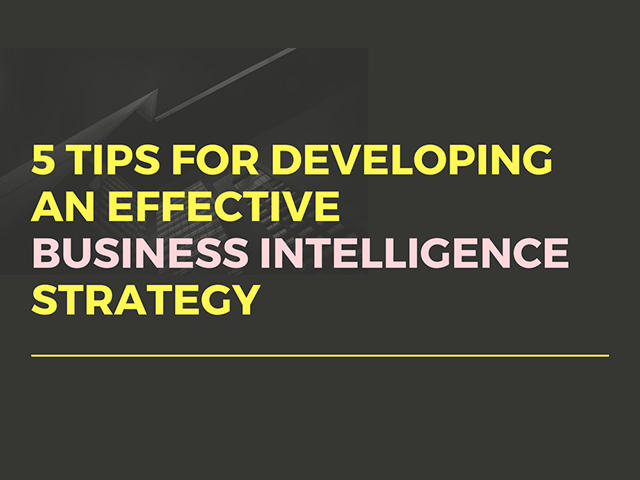The buzz word that we kept hearing last year was Business Intelligence. Much has been spoken about business intelligence – how it helps in creating new business opportunities, simplify business decisions, and avoid digital disruption.
Whatever the requirement, business intelligence (BI) is key for enterprises to stay relevant in today’s ever-changing business landscape. In this blog post, we will discuss the five important tips that you need to develop an effective business intelligence strategy.
An effective business intelligence strategy starts with an overview of your enterprise – both in terms of business and technical standpoint. For your strategy to work, it should include both aspects and should support both. Additionally, your strategy should have long-terms and short-term goals, where the short-term goals help you gain a significant advantage in the long-term goals.
1. Identifying the right KPI’s
Implementing a BI strategy in an organization should not be a technical exercise but need to be aligned to meet the business goals so it is very important that the right audience is involved in defining the strategy from both IT and Business perspective. It is important that a BICC (Business Intelligence Competency Centre is setup) which would own the entire process of defining the strategy. They would then involve the right stakeholders for Business and understand what is the goals of the organization based on any strategy sessions they have conducted or Implementing a Balanced Score Card Strategy based on this they would understand what are the KPI’s (Key Performance Indicators they need to measure and where is the data going to come from. This ensures that the BI strategy definition and subsequently the Implementation is just not a technical exercise and is aligned with what the Business wants.
The KPI’s would be of two types
- Strategic KPI’s like Sales Actual Vs Target, Profit Margin, CSAT etc… based on organizational goals to be achieved.
- Operational KPI’s which would be the drivers of these key KPI’s like for Reject Ratio for a Plant or System line in a production line which would impact the profits and operational efficiency.
2. Data
One of the crucial elements for any business is data. And for any BI strategy to thrive, it needs a reliable data source. Most enterprises, in some way, have a process to collect and analyze data. However, the difference between a successful business and a failed business is their data source.
It becomes very important for us to identify systems and the data required based on business priorities from the various ERP and other LOB systems which exist within the organization. Not just acquiring data, its quality and structure should be aligned with your business objectives. We need to ensure that key elements of data required for a BI Strategy is implemented.
Data Quality
Ensuring that there are no duplicates of masters and all the required information is present is very important.
For Example: A customer might exist multiple times with slightly different names:
- ABC Retail
- ABCRetail
This would impact the way the data is analyzed.
Master Data Governance
Ensuring that the data quality issues does not repeat is important and putting proactive measures to make that happen is important and this can be achieved by Implementing a Master Data Governance Solution with data custodians mapped to ensure that the ERP and any other LOB applications have the right master data.
Data Dictionary Definition
A common data dictionary needs to be defined across various systems so that the entities based on which we need to analyze is easily identifiable across systems as they might be referred with different names in multiple systems.
3. Warehousing
Once you have your data, where would you store it? Data warehousing is crucial for any enterprise/business. Data warehouses are the single-source repository or the single version of truth for any organization. They hold the data that you’ve collected from various sources and transformed based on the business rules.
Why do you need a data warehousing solution?
You would need a complete data warehousing solution so that you can effectively store, retrieve, and curate data for your analysis. You would need to identify the technical stack for this whether you are looking for an on prem or a cloud based solution or you want to go with different providers for your ETL layer and a different one for you DWH layer.
Have A business Intelligence Project in Mind?
Acuvate is regarded as a global leader in the BI services spaces
Currently the warehousing solutions are moving upwards. Cloud based warehousing solutions are the vogue: they offer world-wide accessibility, reduce latency, are secure, and reduce your costs spent on on-prem solutions.
Cloud based data warehousing solutions allows for every stakeholder to access the same information, which is revolutionary when compared to on-prem solutions.
4. Analytics and Reporting
Once you define the strategy for your DWH the next logical step is to define the strategy for your Analytical and Reporting needs across business users who will have varying needs.
- CXO’s and Senior Management
- Information Analyzers
- Operational Users
This will require a combination of Dashboard capability for monitoring key KPI’s , Statistical and Analytical tools for slice and dice analytics and data mining and operational reports which gives operational information for business users related to their operations typically for users based on the field or shop floors etc..
All this need to be achieved while keeping in mind the devices these business users use which means these should be accessible across devices ranging from desktops to tablets to mobile devices.
One other Important aspect to consider is the Self-Service BI aspect where the business users get the ability to create their own reports based on the business need without always having to rely on IT to have developers created for them.
Having pretty reports will not satisfy decision makers, while it is a concern.
Your reporting mechanism or visualization tools should be able to represent data in the simplest way possible, while being visually pleasing.
5. Off the shelf or bespoke?
With the cost of BI coming down over the last five years, enterprises are starting to create bespoke internal solutions for themselves. However, the below chart depicts the feasibility of such bespoke solutions.

Although bespoke solutions are great, they take months to develop. The entire purpose of having BI is lost if you must wait a few months to gather knowledge. Additionally, you will have to tailor the solution to meet the needs based on the ERP and LOB systems present in your organization and also the existing spreadsheet apps, analytical tools etc.
Off the shelf BI apps can be deployed almost instantly. They only need to be integrated with your existing systems but they are not easily customizable and might not meet the needs of business users and expect the data to be structured in a specific way and this is usually good for a reporting solution for a point system.
In between the two is solutions developed by Service providers which have the best of both the bespoke application and product as the data models which are built are generic and can integrate data from any applications present in the organization and can be customized based on the needs og the organization. The report packs which are built are based on the knowledge they have leveraged in implementing similar solutions to various customers and the customizations required for the same without having it tied to a specific product.
If you are looking to deploy such a BI solution which gives you the best of the both the worlds to solve the Business Intelligence needs if your organization we at Acuvate offer a myriad of solutions services for BI across various verticals and horizontals , click here to know more.
Decision makers need a plethora of information at their fingertips. This information should be easily digestible.
Does the BI strategy implemented in your organization help the business users take decisions , do the reports you generate help you in making better decisions? This would be the first and most crucial question you need to ask yourself to know if you have defined and implemented a successful BI strategy.
If you’d like to learn more about this topic, please feel free to get in touch with one of our experts for a personalized consultation.



